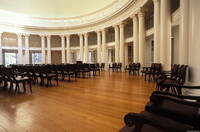Rotunda (University of Virginia)
Jefferson, Thomas

Download1A1-JT-UV-1-F6_cp.jpg (374.0Kb)
Alternative Title
The Rotunda
Date
1822-1826Description
View of the top floor rotunda meeting hall, depicting colonnade; The grounds of the new university were unique in that they surrounded a library housed in the Rotunda rather than a church, as was common at other universities in the English-speaking world. The Rotunda is seen as a lasting symbol of Jefferson's belief in the separation of church and education, as well as his lifelong dedication to both education and architecture. In 1976 during America's Bicentennial, the Rotunda was restored, at a cost of $2.4 million, to Jefferson's original design. (It had burnt down in 1895 and altered in the 1898 rebuilding). "Jefferson designed the Rotunda, basing it on the Pantheon in Rome with its proportions reduced by one half. This magnificent and domed building, with two tiers of windows behind the six-columned portico and pediment, faces the lawn, with a view of the distant mountains. Jefferson subtly emphasized the view by gradually increasing the spaces between the pavilions, thus falsifying the perspective and increasing the apparent length of the lawn. The interior of the Rotunda was designed with a ground floor for scientific experiments, the main first floor for lectures and the top floor for the library." Source: Grove Art Online; http://www.groveart.com/ (accessed 11/7/2007)
Type of Work
university; classroomSubject
architectural exteriors, Neoclassical, Palladian
Rights
Rights Statement
Licensed for educational and research use by the MIT community only